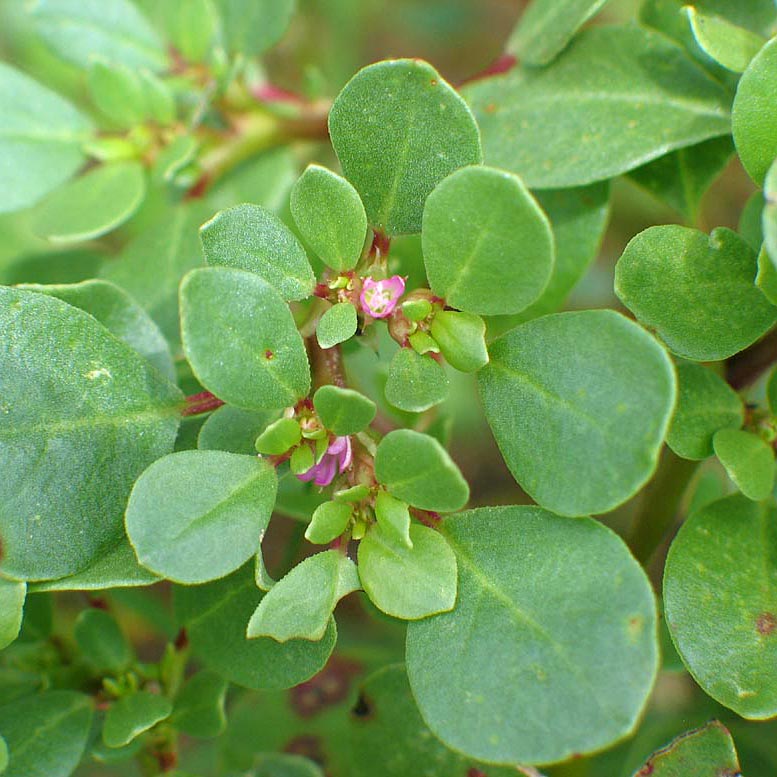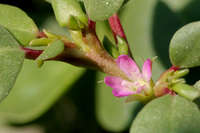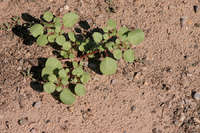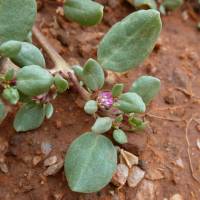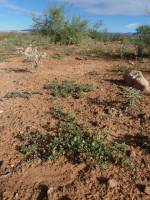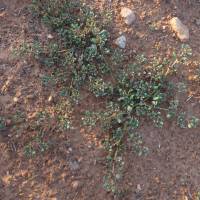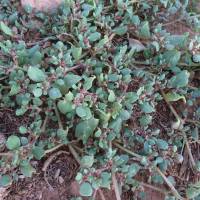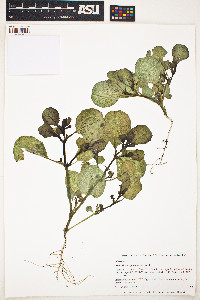|
|
|
|
Family: Aizoaceae
desert horsepurslane
|
Plants annual, succulent, usually glabrous. Stems prostrate or decumbent, diffusely branched, to 10 dm; young branches with lines of minute hairs proximal to petioles. Leaves: unequal pairs alternating along stem; stipules dilated at base; petiole usually equaling blade; blade elliptic to orbiculate, to 4 cm, apex obtuse, often notched, or apiculate. Inflorescences: flowers usually solitary, sessile, in axils of smaller leaves (bracts) of some pairs, partly covered by sheathing stipule of bracts; bracteoles connate, 1-1.5 mm, apex acute. Flowers: calyx 3-5 mm; calyx lobes purple adaxially, lanceolate, 2.5 mm; stamens 5-10. Capsules cylindric, ± curved, 4-5 mm, corky, basal portion appearing embedded in stem, apical portion containing 1 seed; apical wings 2, prominent, erect, crestlike. Seeds ca. 7, dull reddish brown to black, ridged, 1.5-2 mm. Flowering spring-fall. Moist or seasonally dry, usually open, wetlands including alkaline flats, playa lakes, banks of rivers, creeks, roadside depressions, beaches, disturbed areas including gardens, irrigated soils and ditches, fields, ballast, stockyards, sidewalks, railroad tracks; 0-1000 m; Ala., Ariz., Ark., Calif., Fla., Ga., La., Md., Miss., Mo., Nev., N.J., N.Mex., N.C., Okla., S.C., Tenn., Tex., Utah, Va.; Mexico; West Indies; Central America; South America; Africa. In Arizona, Trianthema portulacastrum is a host plant of the beet leafhopper (T. H. Kearney and R. H. Peebles 1960). Seed dispersal is achieved by several methods: one seed is dispersed in the detached cap of the capsule, which can float, and the other seeds are either dispersed individually from the capsule or remain on the annual, parent plant where they will germinate and establish new plants where the parent once grew or was deposited.
Perennial, glabrous or sparsely hairy, diffusely branched from the base, decumbent or ascending, to 1 m; lvs round-obovate, 1-4 cm, slender-petiolate, the members of a pair somewhat unequal; fls sessile, partly concealed in the petiolar sheath; stamens 5-10; ovary unilocular, style 1; membranous hypanthium and small cal pushed off by growth of the fr; fr 4-5 mm; asymmetrically crested around the broad top; seeds 1-4, rough, 2 mm. Widespread tropical weed, extending n. to Okla. and Mo., and rarely about our Atlantic ports. May-Sept. Reputedly poisonous to livestock. Gleason, Henry A. & Cronquist, Arthur J. 1991. Manual of vascular plants of northeastern United States and adjacent Canada. lxxv + 910 pp. ©The New York Botanical Garden. All rights reserved. Used by permission. Kearney and Peebles 1969, FNA 2004, Correll and Johnston 1970 Duration: Annual Nativity: Native Lifeform: Forb/Herb General: Semisucculent annual herb, emerging during the monsoon season; stems weak and prostrate, 15–60 cm long, reddish green and glabrous. Leaves: Opposite along the stems, on wide succulent petioles; blades obovate to orbicular, 3–5 cm long on robust, young plants, and smaller and thicker, 2 cm long, on older plants; expanded petiole bases and stipules form a membranous sheath around stem. Flowers: Pink-purple and solitary in leaf axils, partly enclosed by the sheath formed by the petiole base; calyx lobes appearing petal-like, 2-3 mm long, pink with a green horn on the back near the tip; petals absent. Fruits: Capsules cylindrical and curved, 4 mm long, with prominent crests; containing several seeds. Ecology: Found in disturbed areas and fields with sandy, gravelly, or rocky soils, from 1,000–4,000 ft (305–1219 m); flowers June–October. Distribution: sw US and n MEX Notes: This is a common summer annual of the low deserts. Look for it in weedy habitats such as desert washes and Tucson backyards. With its ground-hugging growth form and opposite, spoon-shaped, succulent leaves, it looks just like Portulaca oleracea at first glance. However, this species has tiny pinkish flowers (P. oleracea has yellow flowers); the capsules have 2 crests on top that look a bit like a pair of mouse ears; and the flowers and fruits are partly hidden in the leaf axils, where they are surrounded by a sheath formed by the base of the leaf petioles and stipules. Ethnobotany: Plants are cooked and eaten as greens in summer. Etymology: Trianthema is from Greek treis for three and anthemon for flower; portulacastrum means resembling the genus Portulaca. Editor: SBuckley 2010, FSCoburn 2015, AHazelton 2017 |


